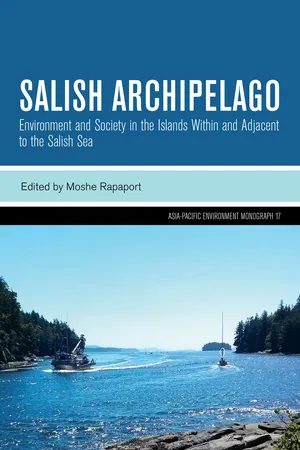
Salish Archipelago
Environment and Society in the Islands Within and Adjacent to the Salish Sea
- 446 pages
- English
- PDF
- Available on iOS & Android
Salish Archipelago
Environment and Society in the Islands Within and Adjacent to the Salish Sea
About this book
The Salish Archipelago includes more than 400 islands in the Salish Sea, an amalgamation of Canada's Georgia Strait, the United States' Puget Sound, and the shared Strait of Juan de Fuca. The Salish Sea and Islands are named for the Coast Salish Indigenous Peoples whose homelands extend across the region.
Holiday homes and services have in many places displaced pristine ecosystems, Indigenous communities, and historic farms. Will age-old island environments and communities withstand the forces of commodity-driven economies? This new, major scholarly undertaking provides the geographical and historical background for exploring such questions.
Salish Archipelago features sections on environment, history, society, and management, accompanied by numerous maps and other illustrations. This diverse collection offers an overview of an embattled, but resilient, region, providing knowledge and perspectives of interest to residents, educators, and policy makers.
Frequently asked questions
- Essential is ideal for learners and professionals who enjoy exploring a wide range of subjects. Access the Essential Library with 800,000+ trusted titles and best-sellers across business, personal growth, and the humanities. Includes unlimited reading time and Standard Read Aloud voice.
- Complete: Perfect for advanced learners and researchers needing full, unrestricted access. Unlock 1.4M+ books across hundreds of subjects, including academic and specialized titles. The Complete Plan also includes advanced features like Premium Read Aloud and Research Assistant.
Please note we cannot support devices running on iOS 13 and Android 7 or earlier. Learn more about using the app.
Information
Table of contents
- Abbreviations
- Contributors
- 1. Introduction
- Part One: Environment
- Part Two: History
- Part Three: Society
- Part Four: Environmental Management
- Epilogue: Reflecting on Change